Western Disturbance
Syllabus:Geography
Context
- A strong Western Disturbance (WD) recently triggered widespread heavy rainfall, storms, hail, and flooding across Delhi and parts of North and South India, disrupting aviation and infrastructure. This event underscores the growing impact of climate change on India’s synoptic weather systems.
What Are Western Disturbances?
- Definition: WDs are eastward-moving extra-tropical weather systems that originate over the Mediterranean, Caspian, and Black Seas.
- Mechanism: They form due to interactions between polar and tropical air masses and are carried into India via the subtropical westerly jet stream.
- Nature: These systems are embedded in high-altitude winds and are often associated with low-pressure areas, bringing rain and snow, particularly during winter.
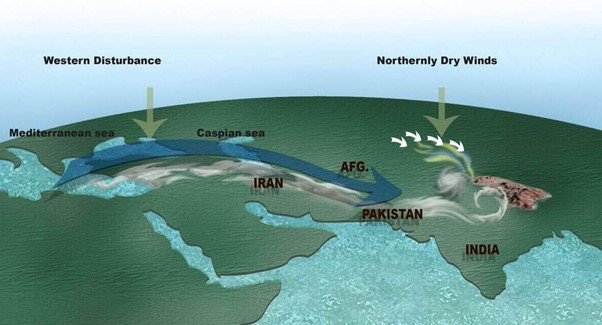
Impact on Indian Weather
- Winter Precipitation: Primary source of rainfall and snow in North India, vital for Rabi crops in Punjab, Haryana, and western Uttar Pradesh.
- Moderation of Heatwaves: Frequent WDs help reduce pre-monsoon heat intensity.
- Extreme Weather Events: Increasingly trigger hailstorms, flash floods, and landslides across Himalayan and central regions.
- Disruption of Urban Life: Lead to flight delays, waterlogging, and urban flooding, notably in Delhi.
- Monsoon Interference: Overlapping WDs disrupt monsoon timing and amplify precipitation variability.
Climate Change and Shifting WD Dynamics
- Rising Frequency & Intensity: Notable surge in WDs, especially in March–April 2025, extending into May–July, well beyond their typical December–March window.
- Jet Stream Intensification: Strengthening of the subtropical westerly jet stream has widened WD pathways, causing greater meridional (north-south) oscillations.
- Arabian Sea Warming: Rising Sea Surface Temperatures (1.2°C–1.4°C) increase atmospheric moisture, enhancing rainfall intensity and flood risk.
- More Extremes in 2025: IMD reported WD-induced hailstorms in Bihar, Himachal, Vidarbha, and flooding in Telangana and Delhi—a stark indicator of changing WD characteristics.
Policy Implications & Way Forward
- Advanced Forecasting: Invest in AI-enabled models, satellite tracking, and radar infrastructure to improve WD prediction accuracy.
- Urban Resilience: Develop city-specific WD mitigation plans, including stormwater drainage upgrades and real-time alert systems.
- Agro-Adaptation: Align sowing calendars and crop insurance with WD behaviour forecasts to safeguard food security.
- Research & Modeling: Promote cross-disciplinary research on WD dynamics and integrate findings into national and state-level climate strategies.
- Regional Cooperation: Collaborate with countries in the Hindu Kush-Himalayan region for transboundary weather risk management.
Conclusion
- Western Disturbances, once winter phenomena, have transformed into year-round climate disruptors. Intensified by global warming, they now overlap with monsoon systems, drive extreme weather, and complicate India’s weather predictability. A science-based, climate-resilient policy framework backed by regional collaboration and inter-state coordination is imperative to mitigate future risks.
Which of the following statements about Western Disturbances (WDs) is/are correct?
- WDs are extratropical cyclones originating from the Mediterranean, Caspian, and Black Seas.
- They primarily affect the Indian subcontinent during the monsoon season.
- The frequency and intensity of WDs have remained constant over the past century.
Select the correct answer using the code below:
a) 1 only
b) 1 and 2 only
c) 1 and 3 only
d) 1, 2, and 3
Answer: a) 1 only
Explanation: WDs are extratropical cyclones originating from the Mediterranean, Caspian, and Black Seas, bringing moisture to the Indian subcontinent. They primarily affect the region during the winter and pre-monsoon seasons, not the monsoon season. Studies have shown that the frequency and intensity of WDs have been influenced by climate change, leading to alterations in their patterns.
Parliamentary Oversight in India
Syllabus: Indian Polity and Governance – Parliament and State Legislatures
Context:
- India’s adoption of a parliamentary system was meant to ensure daily executive accountability. However, recent developments indicate an erosion in Parliament’s oversight function, with increasing disruptions, underutilised committees, and a near-absence of post-legislative review mechanisms.
Understanding Parliamentary Oversight
- Definition:
Parliamentary oversight refers to the continuous monitoring and evaluation of executive actions by the legislature. It ensures transparency, accountability, and responsiveness in governance.
Constitutional Basis:
- Article 75: The Council of Ministers is collectively responsible to the Lok Sabha.
- Oversight Instruments: Include Question Hour, Zero Hour, debates, motions (adjournment, no-confidence), and Parliamentary Committee reports.
- B.R. Ambedkar’s Vision:Described parliamentary democracy as a system of “more responsibility, less stability,” highlighting the need for constant executive accountability through legislative scrutiny.
Key Challenges Undermining Oversight
- Disruption of Question Hour
- In the 17th Lok Sabha, only 60% of Question Hour functioned; Rajya Sabha fared worse at 52%.
- Example: The 2021 Pegasus spyware controversy saw repeated disruptions, preventing targeted questions.
Ineffective Utilisation of Committees
- Standing Committees produce detailed reports, but these are rarely discussed in Parliament.
- Annual membership rotation weakens domain continuity and expertise.
- Example: The 2021 Environment Committee’s report on Delhi’s pollution lacked follow-up debate or action.
Absence of Post-Legislative Scrutiny (PLS)
- India lacks a structured mechanism to evaluate laws after enactment.
- Example: The Companies (Amendment) Act, 2013, aimed at compliance simplification, led to a spike in prosecutions due to poor review.
Reforms for Enhanced Oversight
Institutionalise Post-Legislative Scrutiny
- UK Model: Mandates law implementation reviews 3–5 years post-enactment.
- India Proposal: Each Department-Related Standing Committee (DRSC) should periodically review major laws like IBC or NEP.
Revamp Committee Functioning
- Translate reports into regional languages and use infographics for wider public understanding.
- Mandate floor discussions on selected committee reports.
- Equip committees with technical staff and data analysts.
- Example: The S. Congressional Research Service (CRS) provides bipartisan policy support — India lacks a comparable body.
Leverage Digital Tools and AI
- Deploy AI to track budget anomalies, audit flags, and scheme implementation failures.
- Example: AI could have identified early irregularities in PM-Kisan, where ineligible farmers received benefits.
Way Forward
- Parliamentary Modernisation Mission: Invest in digital infrastructure, multilingual dissemination, and a non-partisan research wing.
- Cross-party Consensus: Ensure functional sittings during Question Hour and legislative debates.
- Citizen Engagement: Introduce public consultation mechanisms on bills and reports.
- Expand Oversight to States: Encourage state legislatures to adopt Standing Committees for federal accountability.
Conclusion
- As former President R. Narayanan asserted in 1993, “Oversight is not to criticise but to strengthen governance.” Revitalising the oversight role of Parliament is crucial to uphold constitutional checks, restore public trust, and ensure that governance remains accountable, participative, and transparent.
Which of the following statements regarding Parliamentary Oversight in India is/are correct?
- The 17th Lok Sabha demonstrated near-complete functionality of Question Hour sessions.
- Post-Legislative Scrutiny (PLS) is a mandated function of all Standing Committees in India.
- Article 75 of the Constitution provides the basis for the executive’s accountability to the legislature.
Select the correct answer using the code below:
a) 1 and 2 only
b) 2 and 3 only
c) 3 only
d) 1, 2, and 3
Answer: c) 3 only
Explanation:
- Statement 1 – Incorrect: In the 17th Lok Sabha, only 60% of the Question Hour functioned; even lower in the Rajya Sabha (52%), indicating reduced oversight, not near-complete functionality.
- Statement 2 – Incorrect: India does not currently mandate post-legislative scrutiny (PLS). It has been recommended as a reform based on models like the UK, but it is not yet a formalised function of Standing Committees.
- Statement 3 – Correct: Article 75 of the Indian Constitution states that the Council of Ministers shall be collectively responsible to the House of the People (Lok Sabha), establishing the core principle of executive accountability to the legislature.
Bacterial Infections in India
Syllabus:Science
Context:
- A recent study published in The Lancet Infectious Diseases reveals that only 8% of bacterial infections in India in 2019 were treated with appropriate antibiotics, highlighting a critical gap in the country’s public health response to antimicrobial resistance (AMR).
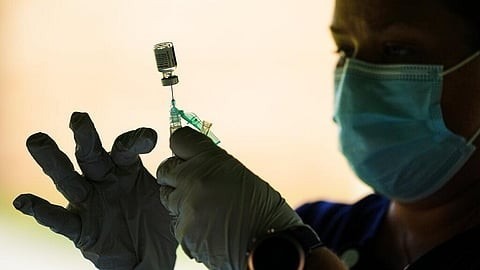
Bacterial Infections in India: Alarming Trends
What are Bacterial Infections?
- Caused by pathogenic bacteria entering the body, commonly leading to diseases like pneumonia, sepsis, and urinary tract infections.
- Require timely and accurate antibiotic administration for recovery and to prevent complications.
India – 2019 Data Highlights:
- Estimated 5 million bacterial infections.
- Carbapenem-resistant strains (a last-resort class of antibiotics) accounted for a majority of cases.
- Courses of antibiotics procured: ~1 lakh (India accounted for 5% or 83,468 courses globally).
- Only 7.8% of infections in India were treated with the appropriate antibiotic.
Implications of Inadequate Treatment:
- Accelerates AMR (Antimicrobial Resistance), weakening future treatment options.
- Contributes to higher morbidity and mortality.
- AMR deaths exceed those from HIV/AIDS and malaria combined:
→ 1 million deaths globally in 2019 directly due to AMR.
→ Projected 40 million global deaths by 2050 if unchecked.
With reference to the challenge of antimicrobial resistance (AMR) in India, consider the following statements:
- In 2019, less than 10% of bacterial infections in India were treated with appropriate antibiotics, despite high procurement of antibiotic courses.
- Carbapenems, one of the most widely used antibiotics in India, are classified as first-line agents for treating common bacterial infections.
- The rise in antimicrobial resistance poses a greater global health threat than HIV/AIDS and malaria combined, in terms of annual mortality.
- India accounted for more than half of the global procurement of antibiotics used against carbapenem-resistant infections in 2019.
Which of the above statements are correct?
A. 1, 2 and 3 only
B. 1, 3 and 4 only
C. 2 and 4 only
D. 1 and 4 only
Correct Answer: B. 1, 3 and 4 only
Explanation:
Statement 1 – Correct: Only 7.8% of bacterial infections in India were treated appropriately in 2019, despite procurement of over 80,000 courses.
Statement 2 – Incorrect: Carbapenems are not first-line antibiotics. They are last-resort antibiotics used when other treatments fail, especially for multi-drug-resistant infections.
Statement 3 – Correct: AMR is now responsible for more deaths annually than HIV/AIDS and malaria combined, with over 1.1 million deaths attributed in 2019.
Statement 4 – Correct: India accounted for 80.5% of the global procurement of antibiotic courses for carbapenem-resistant infections.
Non-Contact Wearable Device
Syllabus:S&T
Context:
- A cutting-edge non-contact wearable device developed by researchers from the U.S. and South Korea enables real-time health monitoring by measuring molecular flux across the skin—without requiring direct skin contact.
About the Non-Contact Wearable Technology:
What is it?
- A compact, smartphone-sized wearable designed to monitor the movement of molecules (flux) across the skin surface, including both outward emissions and inward absorption—without direct contact.
Developed under the leadership of Prof. John A. Rogers at Northwestern University, USA.
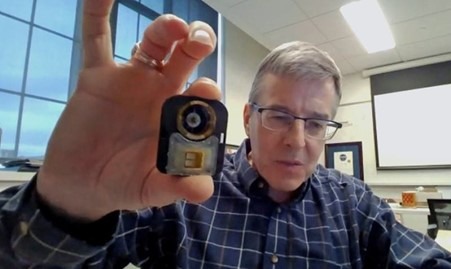
How it Functions:
- Utilizes a sealed microchamber adjacent to the skin to create a controlled environment.
- Integrated with wireless electronics and nanosensors that detect:
- Water vapour
- Carbon dioxide (CO₂)
- Volatile Organic Compounds (VOCs)
- A remote-controlled valve alternates the chamber’s openness, enabling comparative measurements of closed versus open skin flux.
Key Applications:
- Medical Diagnostics:
- Wound healing in diabetic ulcers and chronic skin conditions.
- Assessment of skin barrier function and hydration for dermatological analysis.
Occupational Health:
- Monitoring exposure to toxic chemicals for industrial workers.
- Telemedicine & Remote Monitoring:
- Non-invasive monitoring for patients in post-COVID care and rural settings.
- Commercial Use:
- Cosmetics and fragrance industries exploring VOC flux for product evaluation.
Significance and Potential Impact:
- Non-invasive: Ideal for sensitive or healing skin; eliminates risk of irritation.
- Bidirectional flux detection: Simultaneously tracks chemical release and absorption.
- Cost-effective and scalable: Suited for large-scale deployment in public healthcare systems.
- Emerging clinical utility: Offers potential to be adopted as a new “vital sign” in digital health diagnostics.
With reference to the recently developed non-contact wearable health monitoring device, consider the following statements:
- The device functions by forming a sealed vacuum chamber directly in contact with the skin to enhance sensor sensitivity.
- It is capable of tracking both the outward release of compounds from the skin and inward absorption of environmental chemicals.
- One of its key public health advantages is enabling non-invasive diagnostics in rural or remote healthcare settings.
Which of the statements given above is/are correct?
A. 2 and 3 only
B. 1 and 2 only
C. 1 and 3 only
D. 1, 2, and 3
Correct Answer: A. 2 and 3 only
Explanation:
- Statement 1 is incorrect: The device forms a microclimate chamber adjacent to the skin, not a vacuum or direct contact chamber.
- Statement 2 is correct: It monitors dual flux—both outgoing vapours (e.g., CO₂, VOCs) and incoming chemical exposure.
- Statement 3 is correct: It enables non-contact, non-invasive health diagnostics, particularly valuable in rural and resource-limited settings.
Archaeological Survey of India
Syllabus:History
Context:
- The Archaeological Survey of India (ASI) is set to expand its Underwater Archaeology Wing (UAW) to explore submerged cultural sites, particularly along the western coast, including Maharashtra.
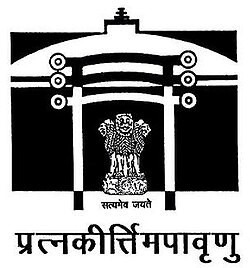
About the Archaeological Survey of India (ASI):
What is ASI?:
- The ASI is the apex government organization tasked with the archaeological research, conservation, and protection of India’s cultural heritage and historical monuments.
- Established: 1861 by Alexander Cunningham during Lord Canning’s tenure.
- Revived: 1871 as an independent department; Cunningham became the first Director-General.
- Headquarters: 24, Tilak Marg, New Delhi.
- Parent Ministry: Ministry of Culture, Government of India.
- Emblem: Derived from the Sanchi Stupa, reflecting India’s rich archaeological legacy.
Mandate and Objectives:
- Protection & Preservation: Safeguards monuments and sites of national importance under the Ancient Monuments and Archaeological Sites and Remains Act, 1958.
- Survey & Excavation: Undertakes systematic exploration and scientific excavations across India.
- Research & Documentation: Publishes reports, journals (e.g., Indian Archaeology – A Review), and conservation manuals.
- Capacity Building: Trains archaeologists and conservationists through in-house institutions.
Underwater Archaeology Wing (UAW):
- A specialized wing focusing on the exploration of submerged archaeological sites along India’s coastline and inland waters.
- Plans to conduct deeper research in states like Maharashtra, aligning with global best practices in maritime archaeology.
- Collaborates with agencies such as the Indian Navy, IITs, and international archaeological institutions.
Which of the following statements regarding the Archaeological Survey of India (ASI) are correct?
- It functions under the Ministry of Education, Government of India.
- The ASI’s logo is inspired by the Sanchi Stupa, a UNESCO World Heritage Site.
- The Underwater Archaeology Wing (UAW) was established to study the tectonic origin of submerged landscapes.
- The ASI was initially founded under Lord Canning’s administration and later revived as a separate department in 1871.
Select the correct answer using the code below:
a) 1 and 3 only
b) 2 and 4 only
c) 1, 2, and 4 only
d) 2, 3, and 4 only
Answer:b) 2 and 4 only
Explanation:
- Statement 1 is incorrect: ASI functions under the Ministry of Culture, not the Ministry of Education.
- Statement 2 is correct: The ASI logo is indeed inspired by the Sanchi Stupa.
- Statement 3 is incorrect: The Underwater Archaeology Wing (UAW) is meant to study submerged cultural heritage, not tectonic origins.
- Statement 4 is correct: ASI was founded in 1861 under Lord Canning, and revived in 1871 under Cunningham.
Sacred Relics of Lord Buddha
Syllabus:History
What Are Sacred Relics?
- Sacred Relics of Lord Buddha refer to the physical remains or personal items associated with Gautama Buddha. These relics are deeply revered by followers worldwide, symbolizing Buddha’s teachings of spiritual enlightenment. They serve as key focal points for devotion and pilgrimage. The relics are preserved and curated by the National Museum of India with support from the Ministry of Culture and the International Buddhist Confederation (IBC).
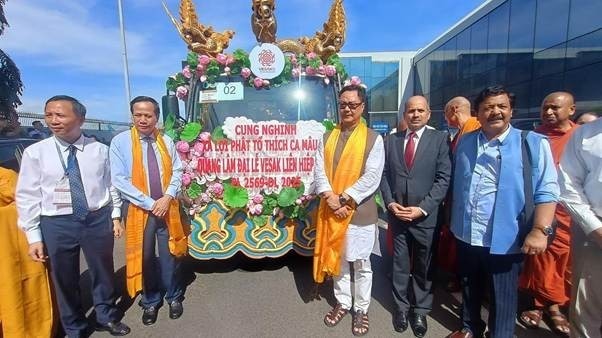
Types of Relics Associated with Buddha
- Saririka Relics: These include Buddha’s physical remains such as bones, teeth, and ashes.
- Paribhogika Relics: Objects used by Buddha, such as his robe, bowl, or walking stick.
- Uddesika Relics: Symbols representing Buddha, such as stupas, images, and sculptures.
Major Relics Associated with Buddha
- Mahabodhi Temple (Bodh Gaya): The site where Buddha attained enlightenment.
- Kapilavastu Relics: Discovered in Piprahwa (Uttar Pradesh), these relics are associated with Buddha’s Shakya clan.
- Tooth Relic (Sri Lanka): Housed in the Temple of the Sacred Tooth Relic in Kandy.
- Sarnath Relics: The site where Buddha delivered his first sermon (Dhammacakkappavattana Sutta).
Significance of the Relics
- The relics symbolize Buddha’s teachings of peace, non-violence, and enlightenment.
- They play a vital role in cultural diplomacy, with India sharing relics with countries like Mongolia, Thailand, and now Vietnam.
- The relics also serve to strengthen Buddhist heritage and foster international ties between nations.
Which of the following is true regarding the Sacred Relics of Lord Buddha?
- Saririka Relics include Buddha’s robe, bowl, or walking stick.
- The Kapilavastu Relics were discovered in Piprahwa, Uttar Pradesh, and are linked to Buddha’s Shakya clan.
- Uddesika Relics are physical remains such as Buddha’s bones, teeth, and ashes.
- The Tooth Relic of Buddha is housed in the Mahabodhi Temple in Bodh Gaya.
Select the correct answer using the code below:
a) 1 and 3 only
b) 2 and 4 only
c) 2 and 3 only
d) 1 and 4 only
Answer:b) 2 and 4 only
Explanation:
- Saririka Relics refer to Buddha’s physical remains like bones, teeth, and ashes, not objects like his robe or walking stick.
- The Kapilavastu Relics were indeed discovered in Piprahwa, Uttar Pradesh, and are associated with Buddha’s Shakya clan.
- Uddesika Relics are symbols representing Buddha, not physical remains.
- The Tooth Relic is housed in Sri Lanka’s Temple of the Sacred Tooth Relic in Kandy, not the Mahabodhi Temple, which is the site of Buddha’s enlightenment.
Enhancing Competitiveness of MSMEs in India Report
Syllabus:Report
Context:
- NITI Aayog has released a report on “Enhancing MSMEs Competitiveness in India,” outlining key reforms necessary for improving financing, skilling, and technology adoption for the growth of Micro, Small, and Medium Enterprises (MSMEs).
- About the “Enhancing MSMEs Competitiveness in India” Report:
Released by:
- NITI Aayog in collaboration with the Institute for Competitiveness (IFC).

Objective:
- To provide a strategic blueprint for enhancing the growth and competitiveness of MSMEs in India through policy reforms in credit access, skilling, innovation, and market linkages.
Key Findings:
- Improvement in Credit Access (2020-24):
- The share of micro and small enterprises accessing formal credit increased from 14% in 2020 to 20% in 2024.
- For medium enterprises, this share grew from 4% to 9% in the same period.
- Despite this, only 19% of total MSME credit demand was met, leaving a gap of ₹80 lakh crore.
Skill & Technology Challenges:
- The report highlights a significant gap in formal vocational training for MSME workers.
- It urges increased investments in Research & Development (R&D) and the upgradation of outdated technology.
- Recommendations include supporting digital marketing, branding, and the adoption of cluster-based technology solutions.
Policy Awareness Gap:
- Many MSMEs remain unaware of available government schemes and initiatives.
- The report calls for better data integration, stakeholder engagement, and state-level monitoring to address this issue.
Regional Focus:
- The report emphasizes the need for targeted support for MSMEs in Northeast and Eastern India, including incentives and logistics partnerships to improve their competitiveness.
About NITI Aayog:
What is NITI Aayog?
- NITI Aayog (National Institution for Transforming India) is India’s apex public policy advisory body, established to replace the Planning Commission in 2015. Its core mandate is to promote cooperative and competitive federalism and foster innovation and sustainable development.
Key Details:
- Established: January 1, 2015
- Mandate: To foster evidence-based policymaking, innovation, and sustainable development.
- Chairperson: The Prime Minister of India
- Vice Chairperson: Appointed by the Government.
Structure:
- Governing Council: Comprising all Chief Ministers, Lieutenant Governors, and Union Ministers.
- Members: Full-time and part-time members drawn from academia, industry, and administration.
Other Notable Reports by NITI Aayog:
- Strategy for New India @75
- India Innovation Index
- SDG India Index
- Export Preparedness Index
- School Education Quality Index (SEQI)
- Ease of Doing Business: State Rankings
- National Multidimensional Poverty Index (MPI)
Which of the following statements are correct regarding NITI Aayog’s report on “Enhancing MSMEs Competitiveness in India”?
- The share of micro and small enterprises accessing formal credit increased from 14% to 20% between 2020 and 2024.
- The report recommends increasing R&D investments but does not emphasize technology adoption for MSMEs.
- The credit demand of MSMEs was fully met during the 2020–2024 period.
Select the correct answer using the code below:
a) 1 only
b) 1 and 2 only
c) 2 and 3 only
d) 1, 2, and 3
Answer: a) 1 only
Explanation:
- Statement 1 is correct as the share of micro and small enterprises accessing formal credit rose from 14% to 20%.
- Statement 2 is incorrect as the report emphasizes both R&D investment and technology adoption.
- Statement 3 is incorrect since only 19% of the total credit demand was met, leaving a significant gap.
National Human Rights Commission (NHRC)
Syllabus:Polity
Context:
- The National Human Rights Commission (NHRC) took suo motu cognizance of a report highlighting poor infrastructure and inadequate manpower in Kerala’s jails, which has hindered inmates’ access to education.
About the National Human Rights Commission (NHRC)
What is the NHRC?
- The National Human Rights Commission (NHRC) is an independent statutory body in India, tasked with the protection and promotion of human rights. It safeguards various human rights, such as the rights to life, liberty, equality, and dignity.
- Established: 12th October 1993 under The Protection of Human Rights Act, 1993.
- Amended Act: The Protection of Human Rights (Amendment) Act, 2019.
- Status: Statutory, autonomous, non-constitutional body.
- Headquarters: New Delhi.
- Composition:
- Chairperson: A retired Chief Justice of India.
Members:
- One serving or retired judge of the Supreme Court.
- One serving or retired Chief Justice of a High Court.
- Two persons with expertise in human rights.
- Ex-officio members: Chairpersons of various National Commissions (e.g., SC, ST, Women, Minorities, etc.).

Powers and Functions:
- Inquiry: NHRC investigates complaints of human rights violations or negligence by public servants. It can act suo motu (on its own initiative) or on petition.
- Visits: NHRC has the authority to visit jails or detention centres to assess conditions and recommend reforms.
- Advisory Role: It advises the government on steps to effectively implement constitutional safeguards and international human rights treaties.
- Research and Promotion: NHRC engages in spreading awareness about human rights through publications, seminars, and training.
- Judicial Powers: NHRC has powers akin to a civil court under the Code of Civil Procedure, 1908, including summoning witnesses, examining them, and collecting evidence.
- Recommendations: The Commission can recommend relief or compensation to victims of human rights violations. However, its recommendations are not legally binding.
Which of the following statements about the National Human Rights Commission (NHRC) is/are correct?
- The NHRC was established under the Protection of Human Rights Act, 1993.
- The Chairperson of the NHRC is a sitting Chief Justice of the Supreme Court of India.
- The NHRC has the authority to make legally binding recommendations to the government.
- The NHRC can investigate complaints related to human rights violations by public servants.
Select the correct answer using the code below:
a) 1 and 4 only
b) 1, 2, and 4 only
c) 1, 3, and 4 only
d) 1, 2, 3, and 4
Answer: a) 1 and 4 only
Explanation:
- Statement 1 is correct: The NHRC was indeed established under the Protection of Human Rights Act, 1993.
- Statement 2 is incorrect: The Chairperson of the NHRC is a retired Chief Justice of India, not a sitting Chief Justice.
- Statement 3 is incorrect: While the NHRC can make recommendations to the government, its recommendations are not legally binding.
- Statement 4 is correct: The NHRC has the power to investigate complaints of human rights violations by public servants and can act suo motu.
World Audio Visual Entertainment Summit 2025
Syllabus:Summits
Context:
- The WAVES (World Audio Visual Entertainment Summit) 2025, held in Mumbai, has facilitated media and entertainment deals worth over ₹250 crore in just 1.5 days, alongside announcing several significant international collaborations.
About WAVES
What is WAVES?
- WAVES (World Audio Visual Entertainment Summit) is an initiative by the Ministry of Information & Broadcasting (I&B) that serves as a global platform for the media and entertainment industry.
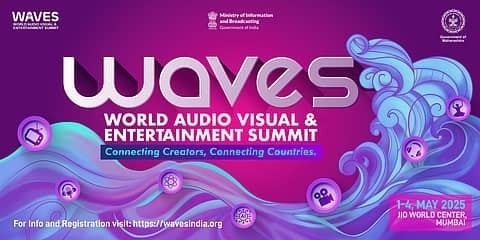
Key Objectives of WAVES:
- Facilitate cross-border collaboration in the media and entertainment sector.
- Promote India as a key global hub for media-related content, including film, OTT platforms, VFX, animation, and music.
- Provide emerging creators with the opportunity to directly engage with global investors, buyers, and collaborators.
- Foster structured B2B transactions and content deals to boost the media and entertainment industry.
Which of the following statements about WAVES (World Audio Visual Entertainment Summit) are correct?
- WAVES is an initiative by the Ministry of Information & Broadcasting to enhance India’s position in the global media and entertainment market.
- It primarily focuses on promoting India as a hub for content commerce related to film, OTT, VFX, animation, and music.
- WAVES is held annually in various cities across the world, with Mumbai being its inaugural location in 2025.
Select the correct answer using the code below:
a) 1 and 2 only
b) 1, 2, and 3
c) 2 and 3 only
d) 1 only
Answer: a) 1 and 2 only
Explanation: WAVES is an initiative by the Ministry of Information & Broadcasting to position India as a global media hub for film, OTT, VFX, animation, and music. It is not held annually in various cities globally but is focused on Mumbai for 2025.
